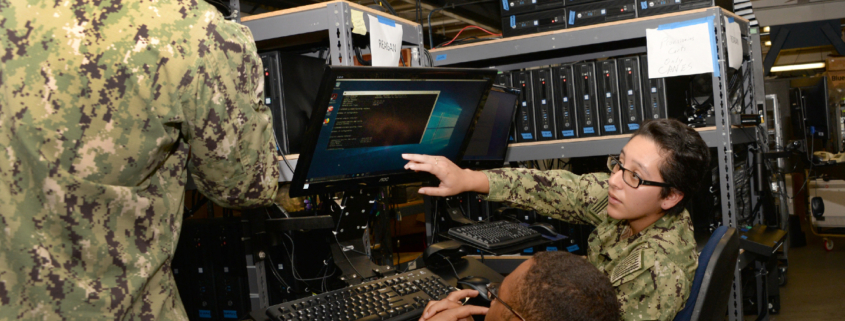Tag Archive for: land
Can’t Sail Away from Cyber Attacks: ‘Sea-Hacking’ from Land
/in Computer Security
The warnings had been issued for years. The techniques were simple enough — penetrate the platform through the onboard navigation system and then go horizontally across the onboard networks to gain control of key systems such as steering and the throttle. The hackers did exactly this — surprisingly without foreknowledge of the specific systems they were to hack prior to beginning the penetration. They were in and through the navigation interface in a remarkably short time and had control of both the steering systems and the throttle in quick succession. From this effort came a coveted “Black Badge” from the Maritime Hacking village of the annual cyber security conference DefCon, held in August 2021 in Las Vegas.
The conference’s Hack the Sea Village “SeaTF” hacking challenge allowed teams of 3–5 individuals to gain hands-on experience hacking real maritime hardware in a controlled environment using Fathom5’s “Grace” maritime cyber security testbed. The simulated maritime bridge setup is meant to be an accurate facsimile of equipment typically in use onboard ocean-going vessels, allowing hacking teams to attack the afloat environment. Using realistic components and protocols, hackers were able to penetrate different maritime subsystems including navigation, firefighting, and steering systems. While this year’s challenge required hackers to tap into propulsion, steering, and navigation systems through a wired connection to their laptops, next year the hope is to provide a wireless environment.
Importantly, the 2021 competition once more demonstrated that hacking skills from land-based systems and environments are easily transposable to a maritime environment. The winning team had neither experience in the simulated environment or in maritime hacking in general. A skilled hacking team typically takes at most 14 hours to penetrate the system safeguards and remotely take control of both steering and throttle controls. While the simulation used at DefCon did require “plugging into” the equipment, remote-access hacking is possible as demonstrated in February 2017, when hackers took control of a German-owned container vessel traveling from Cyprus to…
To Survive, Deceive: Decoys in Land Warfare
/in Internet Security
Editor’s Note: This article has been adapted from a paper in French published in Défense & Sécurité Internationale (DSI).
In a black-and-white photo seen in many books and newspapers to illustrate the deception integral to the D-Day invasion, four men carry a 30-ton Sherman tank near what seems to be a barrack. This famous image is bizarre. Of course, what it shows is an inflatable tank, a decoy that was used in the vast and complex deception operation around the 1944 Normandy landings. Land tactical decoys are dummy equipment like armored vehicles, bridging capabilities, artillery pieces, and radars or installations (buildings, bridges, and runways) intended to deceive enemy observers. Their use has been standard in warfare since ancient times. Among the countless examples, relatively contemporary decoys include the Quaker guns of the U.S. Civil War, which were logs simulating artillery pieces; “horses” made of wood and blankets used by the British at the Battle of Megiddo in September 1918; the construction by Her Majesty’s Sappers of 8,400 dummy vehicles and devices of all kinds for Operation Bertram in 1942; and, more recently, various decoys to deceive enemy aircraft used by the Iraqis in 1990 and 1991, the Serbs in Kosovo in 1999, the self-styled Islamic State group in Syria and Iraq, the Houthis in Yemen, and Armenians and Azerbaijanis in Nagorno-Karabakh in 2020. Unsurprisingly, major potential adversaries of Western countries have kept a place for decoys in their armed forces: China seems well equipped and appears to give decoys a prominent place in its maneuvers, for example, and North Korea is reportedly using decoys intensively to protect its equipment and plans to use them extensively in warfare. Faithful to its longtime military doctrine of maskirovka, or deception, Russia pays special attention to decoys and even has a dedicated unit (the 45th Independent Camouflage Regiment) stationed near Nakhabino in the Moscow region.
Western armies, however, appear to have dropped decoys from their inventories. The main reason is that for too long, they have benefited from “operational comfort” and, in particular, undisputed air superiority during interventions…
Paying Evil Corp Ransomware Might Land You a Big Federal Fine – WIRED
/in Computer SecurityPaying Evil Corp Ransomware Might Land You a Big Federal Fine WIRED
“malware news” – read more


